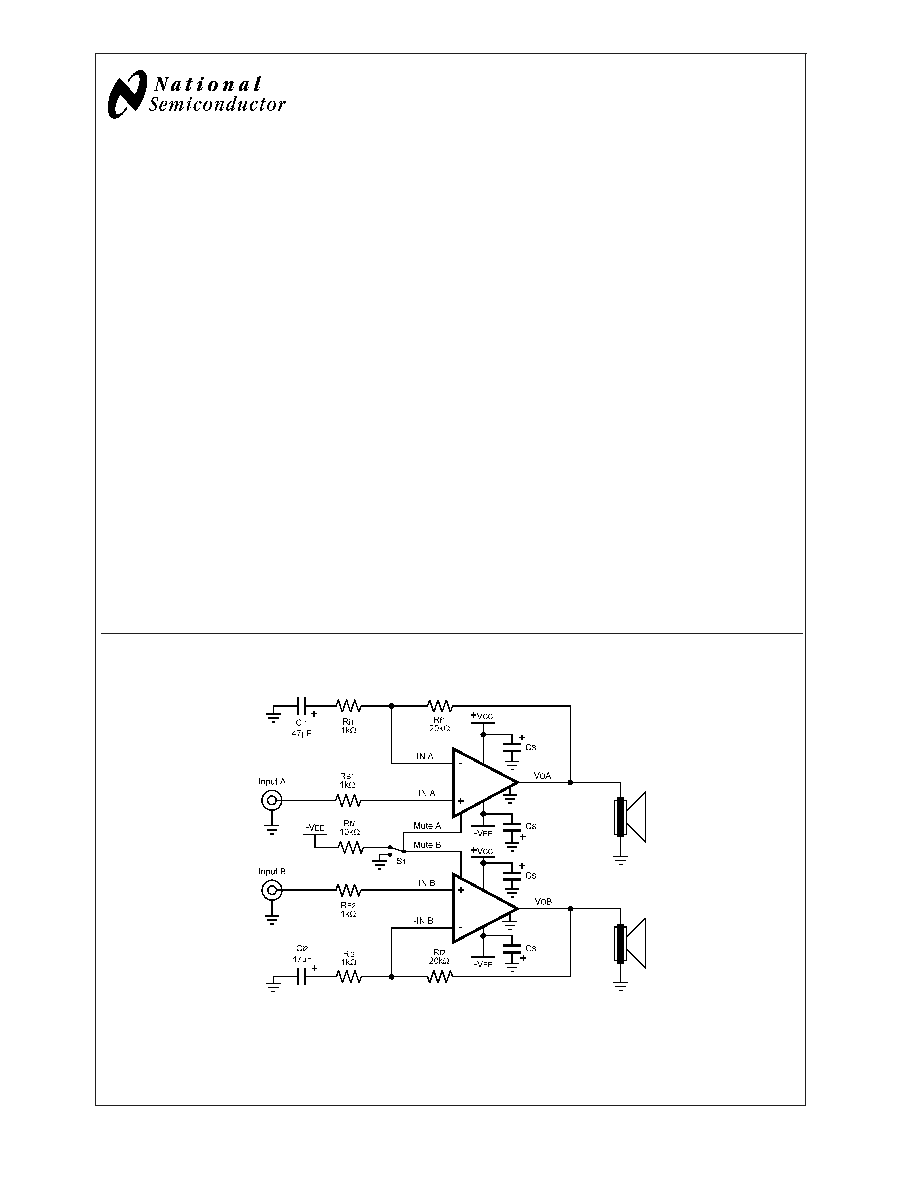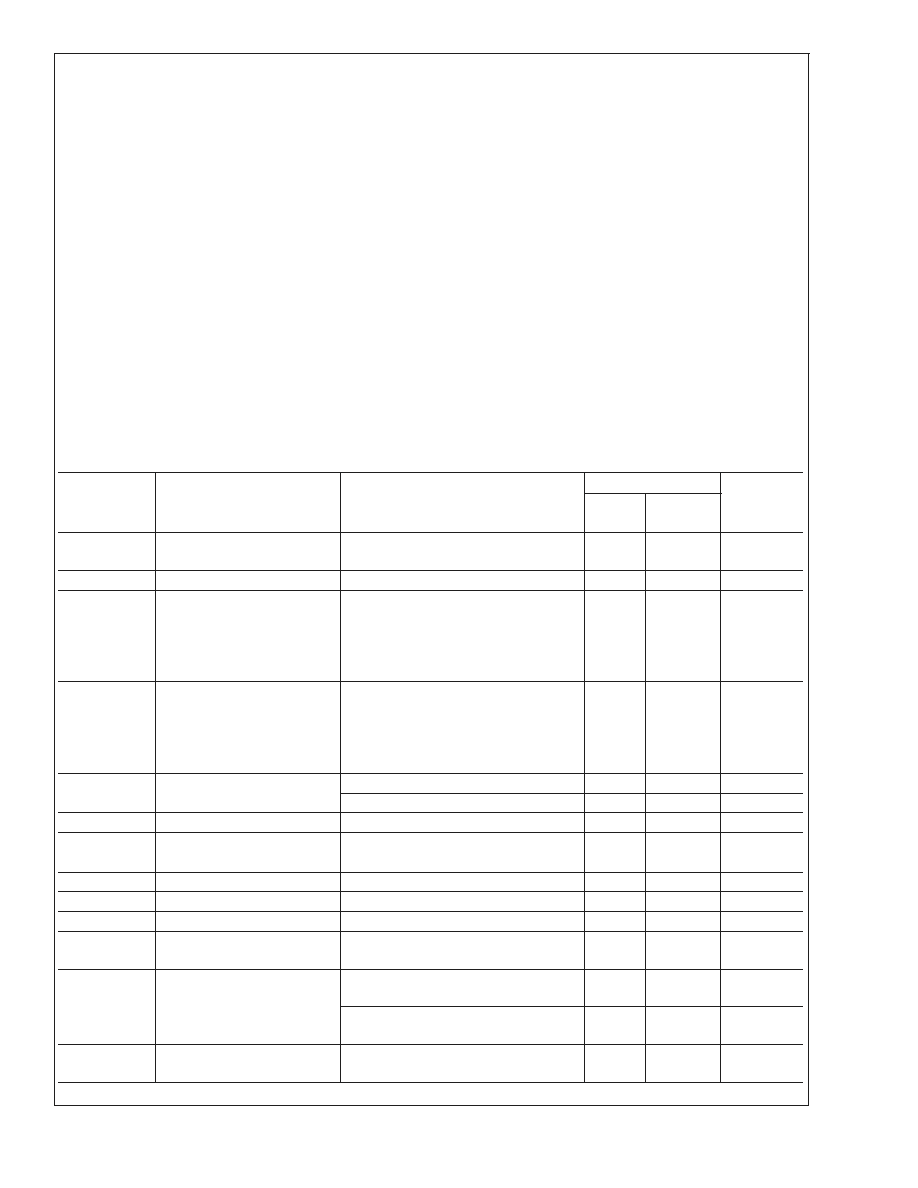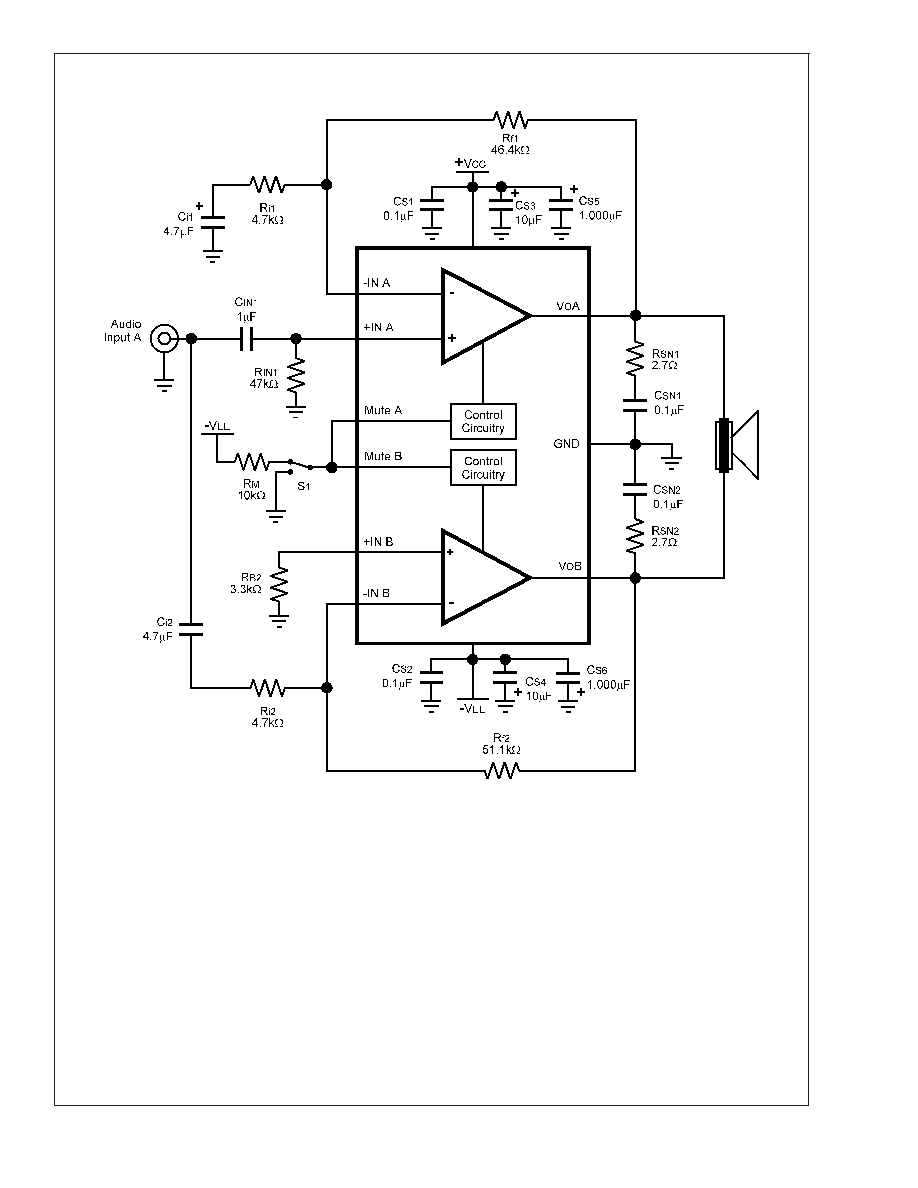
LM4780 Overture
TM
Audio Power Amplifier Series
Stereo 60W, Mono 120W Audio Power Amplifier with
Mute
General Description
The LM4780 is a stereo audio amplifier capable of typically
delivering 60W per channel of continuous average output
power into an 8
load with less than 0.5% THD+N from
20Hz - 20kHz.
The LM4780 is fully protected utilizing National's Self Peak
Instantaneous Temperature (°Ke) (SPiKe
TM
) protection cir-
cuitry. SPiKe provides a dynamically optimized Safe Operat-
ing Area (SOA). SPiKe protection completely safeguards the
LM4780's outputs against over-voltage, under-voltage, over-
loads, shorts to the supplies or GND, thermal runaway and
instantaneous temperature peaks. The advanced protection
features of the LM4780 places it in a class above discrete
and hybrid amplifiers.
Each amplifier of the LM4780 has an independent smooth
transition fade-in/out mute.
The LM4780 can easily be configured for bridge or parallel
operation for 120W mono solutions.
Key Specifications
n
Output Power/Channel with 0.5% THD+N, 1kHz into
8
60W (typ)
n
THD+N at 2 x 30W into 8
(20Hz - 20kHz) 0.03% (typ)
n
THD+N at 2 x 30W into 6
(20Hz - 20kHz) 0.05% (typ)
n
THD+N at 2 x 30W into 4
(20Hz - 20kHz) 0.07% (typ)
n
Mute Attenuation
110dB (typ)
n
PSRR
85dB (min)
n
Slew Rate
19V/µs (typ)
Features
n
SPiKe Protection
n
Low external component count
n
Quiet fade-in/out mute mode
n
Wide supply range: 20V - 84V
n
Signal-to-Noise Ratio
97dB (ref. to P
O
= 1W)
Applications
n
Audio amplifier for component stereo
n
Audio amplifier for compact stereo
n
Audio amplifier for self-powered speakers
n
Audio amplifier for high-end and HD TVs
Typical Application
SPiKe
TM
Protection and Overture
TM
are trademarks of National Semiconductor Corporation.
20058622
FIGURE 1. Typical Audio Amplifier Application Circuit
July 2003
LM4780
Overture
TM
Audio
Power
Amplifier
Series
Stereo
60W
,
Mono
120W
Audio
Power
Amplifier
with
Mute
© 2003 National Semiconductor Corporation
DS200586
www.national.com

Absolute Maximum Ratings
(Notes 1,
2)
If Military/Aerospace specified devices are required,
please contact the National Semiconductor Sales Office/
Distributors for availability and specifications.
Supply Voltage |V
+
| + |V
-
|
(No Signal)
94V
Supply Voltage |V
+
| + |V
-
|
(Input Signal)
84V
Common Mode Input Voltage
(V
+
or V
-
) and
|V
+
| + |V
-
|
80V
Differential Input Voltage (Note 13)
60V
Output Current
Internally Limited
Power Dissipation (Note 3)
125W
ESD Susceptability (Note 4)
3.0kV
ESD Susceptability (Note 5)
200V
Junction Temperature (T
JMAX
) (Note 9)
150°C
Soldering Information
TA Package (10 seconds)
260°C
Storage Temperature
-40°C to +150°C
Thermal Resistance
JA
30°C/W
JC
0.8°C/W
Operating Ratings
(Notes 1, 2)
Temperature Range
T
MIN
T
A
T
MAX
-20°C
T
A
+85°C
Supply Voltage |V
+
| + |V
-
|
20V
V
TOTAL
84V
Note: Operation is guaranteed up to 84V; however, distor-
tion may be introduced from SPiKe protection circuitry if
proper thermal considerations are not taken into account.
Refer to the Thermal Considerations section for more
information.
Electrical Characteristics
(Notes 1, 2)
The following specifications apply for V
+
= +35V, V
-
= -35V, I
MUTE
= -1mA and R
L
= 8
unless otherwise specified. Limits ap-
ply for T
A
= 25°C.
Symbol
Parameter
Conditions
LM4780
Units
(Limits)
Typical
Limit
(Note 6)
(Notes 7, 8)
|V
+
| + |V
-
|
Power Supply Voltage (Note
10)
GND - V
-
9V
18
20
84
V (min)
V (max)
A
M
Mute Attenuation
I
MUTE
= 0mA
110
80
dB (min)
P
O
Output Power (RMS)
THD+N = 0.5% (max)
f = 1kHz; f = 20kHz
|V
+
| = |V
-
| = 25V, R
L
= 4
|V
+
| = |V
-
| = 30V, R
L
= 6
|V
+
| = |V
-
| = 35V, R
L
= 8
55
55
60
50
50
50
W (min)
W (min)
W (min)
THD+N
Total Harmonic Distortion +
Noise
P
O
= 30W, f = 20Hz - 20kHz
A
V
= 26dB
|V
+
| = |V
-
| = 25V, R
L
= 4
|V
+
| = |V
-
| = 30V, R
L
= 6
|V
+
| = |V
-
| = 35V, R
L
= 8
0.07
0.05
0.03
%
%
%
X
talk
Channel Separation (Note 11)
P
O
= 10W, f = 1kHz
70
dB
P
O
= 10W, f = 10kHz
72
dB
SR
Slew Rate
V
IN
= 2.0V
P-P
, t
RISE
= 2ns
19
8
V/µs (min)
I
DD
Total Quiescent Power
V
CM
= 0V,
110
170
mA (max)
Supply Current
V
O
= 0V, I
O
= 0A
V
OS
Input Offset Voltage
V
CM
= 0V, I
O
= 0mA
1
10
mV (max)
I
B
Input Bias Current
V
CM
= 0V, I
O
= 0mA
0.2
1
µA (max)
I
O
Output Current Limit
|V
+
| = |V
-
| = 20V, t
ON
= 10ms
11.5
7
A (min)
V
OD
Output Dropout Voltage
(Note 12)
|V
+
- V
O
|, V
+
= 28V, I
O
= +100mA
|V
-
- V
O
|, V
-
= -28V, I
O
= -100mA
1.6
2.5
2.0
3.0
V (max)
V (max)
PSRR
Power Supply Rejection Ratio
(Note 15)
V
+
= 40V to 20V, V
-
= -40V,
V
CM
= 0V, I
O
= 0mA
120
85
dB (min)
V
+
= 40V, V
-
= -40V to -20V,
V
CM
= 0V, I
O
= 0mA
105
85
dB (min)
CMRR
Common Mode Rejection Ratio
(Note 15)
V
+
= 60V to 20V, V
-
= -20V to -60V,
V
CM
= 20V to -20V, I
O
= 0mA
110
85
dB (min)
LM4780
www.national.com
3

Electrical Characteristics
(Notes 1, 2) (Continued)
The following specifications apply for V
+
= +35V, V
-
= -35V, I
MUTE
= -1mA and R
L
= 8
unless otherwise specified. Limits ap-
ply for T
A
= 25°C.
Symbol
Parameter
Conditions
LM4780
Units
(Limits)
Typical
Limit
(Note 6)
(Notes 7, 8)
A
VOL
Open Loop Voltage Gain
R
L
= 2k
, V
O
= 40V
115
90
dB (min)
GBWP
Gain Bandwidth Product
f
IN
= 100kHz, V
IN
= 50mV
RMS
8
2
MHz (min)
e
IN
Input Noise
IHF-A-Weighting Filter,
R
IN
= 600
(Input Referred)
2.0
10
µV (max)
SNR
Signal-to-Noise Ratio
P
O
= 1W
RMS
; A-Weighted Filter
f
IN
= 1kHz, R
S
= 25
97
dB
P
O
= 50W
RMS
; A-Weighted Filter
f
IN
= 1kHz, R
S
= 25
114
dB
IMD
Intermodulation Distortion
60Hz, 7kHz, 4:1 (SMPTE)
60Hz, 7kHz, 1:1 (SMPTE)
0.004
0.009
%
%
Note 1: All voltages are measured with respect to the ground pins, unless otherwise specified.
Note 2: Absolute Maximum Ratings indicate limits beyond which damage to the device may occur. Operating Ratings indicate conditions for which the device is
functional, but do not guarantee specific performance limits. Electrical Characteristics state DC and AC electrical specifications under particular test conditions which
guarantee specific performance limits. This assumes that the device is within the Operating Ratings. Specifications are not guaranteed for parameters where no limit
is given; however, the typical value is a good indication of device performance.
Note 3: The maximum power dissipation must be de-rated at elevated temperatures and is dictated by T
JMAX
,
JC
, and the ambient temperature T
A
. The maximum
allowable power dissipation is P
DMAX
= (T
JMAX
-T
A
)/
JC
or the number given in the Absolute Maximum Ratings, whichever is lower. For the LM4780, T
JMAX
= 150°C
and the typical
JC
is 0.8°C/W. Refer to the Thermal Considerations section for more information.
Note 4: Human body model, 100pF discharged through a 1.5k
resistor.
Note 5: Machine Model: a 220pF - 240pF discharged through all pins.
Note 6: Typical specifications are measured at 25°C and represent the parametric norm.
Note 7: Tested limits are guaranteed to National's AOQL (Average Outgoing Quality Level).
Note 8: Datasheet min/max specification limits are guaranteed by design, test, or statistical analysis.
Note 9: The maximum operating junction temperature is 150°C. However, the instantaneous Safe Operating Area temperature is 250°C.
Note 10: V
-
must have at least - 9V at its pin with reference to GND in order for the under-voltage protection circuitry to be disabled. In addition, the voltage
differential between V
+
and V
-
must be greater than 14V.
Note 11: Cross talk performance was measured using the demo board shown in the datasheet. PCB layout will affect cross talk. It is recommended that input and
output traces be separated by as much distance as possible. Return ground traces from outputs should be independent back to a single ground point and use as
wide of traces as possible.
Note 12: The output dropout voltage is defined as the supply voltage minus the clipping voltage. Refer to the Clipping Voltage vs. Supply Voltage graph in the
Typical Performance Characteristics section.
Note 13: The Differential Input Voltage Absolute Maximum Rating is based on supply voltages V
+
= 40V and V
-
= - 40V.
Note 14: The TA27A is a non-isolated package. The package's metal back, and any heat sink to which it is mounted are connected to the V
-
potential when using
only thermal compound. If a mica washer is used in addition to thermal compound,
CS
(case to sink) is increased, but the heat sink will be electrically isolated from
V
-
.
Note 15: DC electrical test.
Note 16: CCIR/ARM: A Practical Noise Measurement Method; by Ray Dolby, David Robinson and Kenneth Gundry, AES Preprint No. 1353 (F-3).
LM4780
www.national.com
4




